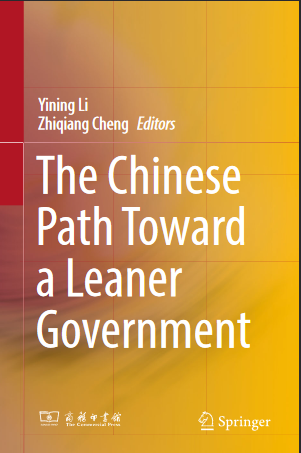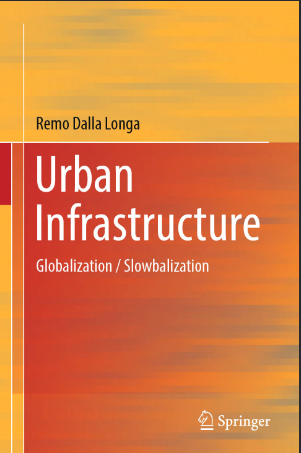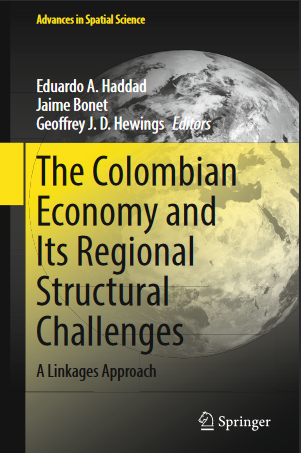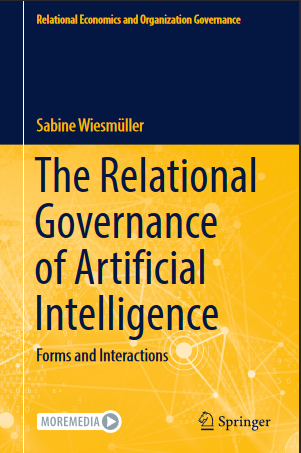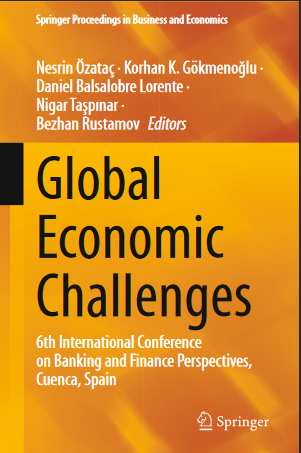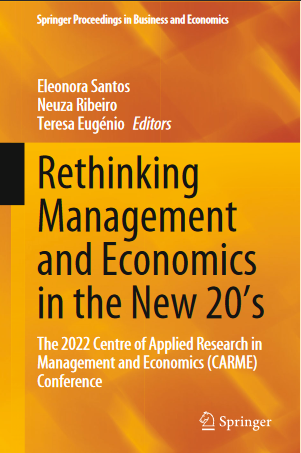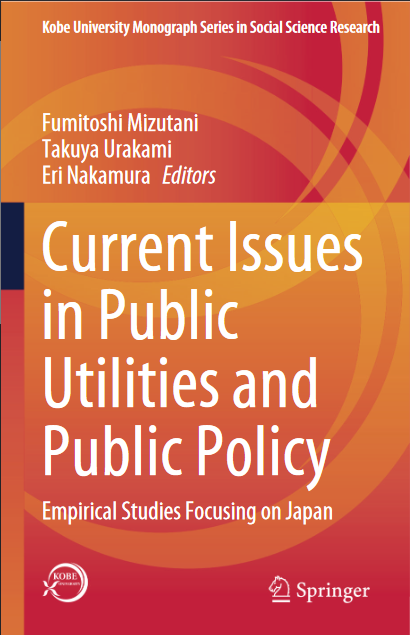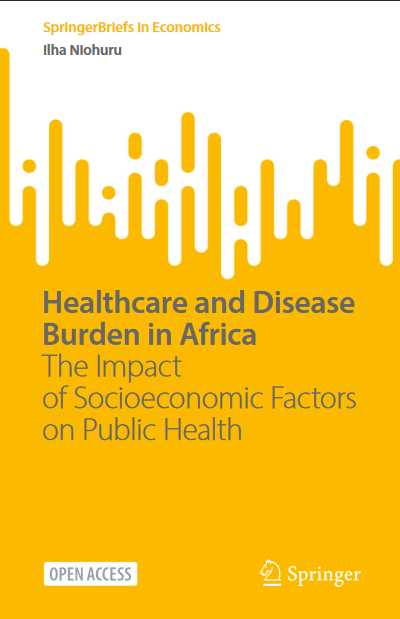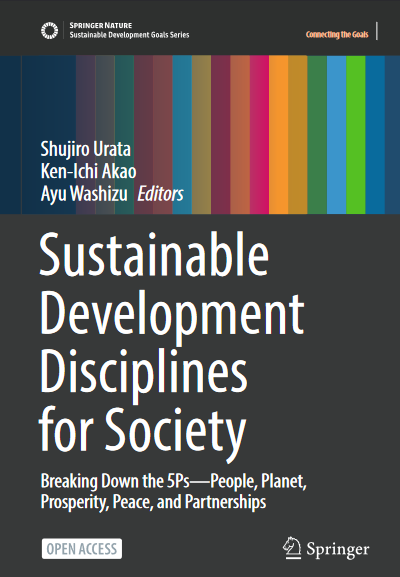موضوعات
آموزش و پرورش
ادبیات و زبان
پزشکی، دندانپزشکی و داروسازی
تاریخ و جغرافیا
داستان و رمان
دیگر
دین و فلسفه
روانشناسی
ریاضیات و آمار
سلامتی، تناسب اندام و رژیم غذایی
شیمی و پلیمر
علوم اجتماعی و حقوق
علوم زیستی و بیوتکنولوژی
فیزیک و نجوم
کامپیوتر و اینترنت
کتابهای کودکان و داستان
کسب و کار و اقتصاد
کشاورزی و دامپزشکی و غذا
معماری
مهندسی و فناوری
هنر و تئاتر
محصولات
The Chinese Path Toward a Leaner Government - Original PDF
نویسندگان: خلاصه: Building a leaner government ( Jian Zheng Fang Quan , or “streamlining admin- istration and delegating powers” in the official translated documents) is essential in China’s transition from a planned economy to a market economy and in an effort to improve the country’s socialist market economy. People of our generation have all had some experiences with the planned economy. It was a time when the government managed everything from production to consump- tion. In other words, the government assumed the role of both the producer and distributor of goods. Little was outside the government administration. It set quotas that matched its plans and organized supplies according to the quotas. No one in China at that time had ever heard about the term Jian Zheng Fang Quan or stream- lining administration and delegating powers. In fact, it was impossible to streamline the government then because everything was controlled by the government, every decision had to come from the higher authorities, and all kinds of stuff were placed under the quota system. When a government assigned each of its staff with a particular task to either manage or supervise economic activities, how could it be streamlined? Power devolution was even more beyond imagination. The planned economy was based on the concentration of power. If power was delegated, how could the economy and people’s daily life go as the government had planned for them? Indeed, there were times when the Chinese government was concerned about the low efficiency and poor performance of the planned economy that too much concentration of power had entailed. However, there were no better ways. China had quite a few lessons learnt in a hard way. Trials to cut government power or remove some quota all ended up in market disorder. Shifting back to old practice only stifled the economy. Such policy flip-flops occurred time after time during the period of the planned economy. It was a doomed cycle that no one was able to breaUrban Infrastructure Globalization / Slowbalization - Original PDF
نویسندگان: خلاصه: The book addresses the issue of urban infrastructures within globalization. Slowbal- ization is then introduced rather than deglobalization to indicate important variables that could stand in the way of a prevailing reading key in the book. Wiig et al (2022) argue that starting from a volume (Graham, Marvin, 2001 ) the study of infrastructures has been brought to the center of urban studies and has inspired the infrastructural turn within urban sciences. Infrastructures, and urban ones in particular, precisely because of their differentiation, specialisms, formulas and organizational models that underlie their assembly, governance and management have always appeared residual compared to other themes such as the city, urbaniza- tion, the form urban, competitive advantage, applied globalization; or on another more technical side, specialisms such as engineering or other technical disciplines called upon to assemble and update the various infrastructures in various ways. Moss (2020) on Berlin, which tells the story of that city (1920–2020) through infrastructures, removing them from invisibility, may be singular, but it is not. Putting them at the center offers new ideas and angles both from the point of view of economics, finance, assembly technique and above all the spatiality of the city within the different forms of globalization. Today, urban infrastructures are also a fundamental part of the economy and finance and follow their evolution and trajectory. They assume particular impor- tance starting from the conjugation with the term globalization; we have seen a rapid transformation of the interconnected infrastructure precisely with the growth of glob- alization and the global city. The analysis focused more on what has been called the western global city and the context of the brownfield infrastructureThe Colombian Economy and Its Regional Structural Challenges A Linkages Approach - Original PDF
نویسندگان: خلاصه: Preface I have been teaching a Ph.D. course on “Applied General Equilibrium Models” at the University of São Paulo, Department of Economics, since 1999. Over the last editions of the course, the material was built around specific countries or regions, selected to be the object of modeling practices undertaken by the students. This praxis turned out to be very rewarding for the students since they were motivated to apply different techniques to study concrete problems in a common economic system. Throughout this process, they had the opportunity to collaborate among themselves and interact with scholars from the study regions, often generating scholarly publications. We had already worked with countries such as Brazil, Chile, Greece, and Paraguay, and with different regional contexts, especially within Brazil. Colombia had always been a top candidate to receive our attention. Our previous engagement with colleagues from the Centro de Estudios Económicos Regionales (CEER), a research center specialized in Regional and Urban Economics at the Banco de la República— the Colombian Central Bank—provided a unique opportunity to develop a special edition of the course on the country. During a visit to Cartagena in 2019, Jaime Bonet and I finally agreed to use Colombia as the case study in the forthcoming edition of the course. We designed the Colombian edition in innovative and challenging ways, raising the bar for the expected outcomes, including a workshop to be hosted in Cartagena in 20201 and the publication of a volume including the contributions by different authors forming a cohesive unit. We built the activities upon solid coThe Relational Governance of Artificial Intelligence Forms and Interactions - Original PDF
نویسندگان: خلاصه: he book “The Relational Governance of Artificial Intelligence—Forms and Inter- actions” by Sabine Wiesmüller deals both with the theoretical prerequisites and prac- tical possibilities of the governance of “Artificial Intelligence” (AI) in the interplay of social, entrepreneurial, and ethical decision-making logics. In particular, Sabine Wiesmüller’s book aims to contribute to the discussion of a theme that all societies are confronted with today and for which solutions are being sought, namely the complex interactions and network effects of the technological, economic and social aspects of AI. The book focuses on a genuinely interdisciplinary analysis: The overlap and rela- tionalisation between economic, system-theoretical, and ethical language games. Only through such a relationalisation—and this is one of the basic assumptions of the author—can the challenges of the rapidly developing technical and economic possi- bilities, risks, and challenges of artificial intelligence in the economy and society be understood and productively dealt with. The aim of the analysis is therefore twofold: On the one hand, it provides a theo- retical literature reconstruction of the polyvalent forms of governance of AI. On the other hand, it also addresses the practical possibilities for an intersectoral imple- mentation of relational governance of AI. The latter means that the governance of AI must enable and promote the cooperation of the multiple stakeholders involved, especially their interests, resources and decision-making logics. It is therefore about the relational governance of economic and social transactions that relationalise tech- nical logic, economic value creation and ethical demands such as self-interest, trust, integrity and stakeholder legitimacy. In this way, the adaptive approach to uncertainty and process dynamics becomes possiblGlobal Economic Challenges 6th International Conference on Banking and Finance Perspectives, Cuenca, Spain - Original PDF
نویسندگان: خلاصه: Price movements in the energy market are crucial because energy plays a vital role in the world’s economies and human life. The high volatility in energy prices since the 1990s is due to several historical developments, including the deregulation of energy markets, the Asian financial crisis in 1997, and the 2008 global financial crisis (Lien et al., 2016; Lang & Auer, 2019) have increased the need for an appro- priate protection strategy. Hedging by using futures contracts makes the problem of “finding an appropriate hedge ratio” vital. In calculating the optimal hedge ratio (OHR), estimations are mostly based on the average (expected) relationship between spot and futures prices. This approach ignores the tail distribution of the variables (Lien et al., 2016; Shrestha et al., 2018). However, the widely documented non- normal distribution of financial variables makes considering the quantiles of the variables essential. To fill this gap, we used the recently developed quantile-on- quantile (Q-Q) (Sim & Zhou, 2015) approach to estimate the minimum-variance (MV) hedge ratio for crude oil, natural gas, and gasoline markets. Besides, to have a better understanding of the relationship between these variables, we examined long-run and causal relationships by using methods that consider the distribution of the variables.Environmental Regulations and Industrial Competitiveness Case Studies of Toxic Industries in Southern California - Original PDF
نویسندگان: خلاصه: 1 Chapter 1 Environmental Regulations and Industrial Competitiveness Abstract Industries in the U.S. emit billions of pounds of toxic chemicals into the environment every year, resulting in a major risk to human health. Many economists and policy makers, however, are strongly opposed to environmental regulations based on an assumption that regulations lead to a loss of jobs and a declining stan- dard of living for U.S. citizens. The empirical literature on this question has pro- duced mixed results, and this chapter critically assesses several conceptual and methodological issues that are embedded in this literature. Our thesis is that strin- gent environmental regulations have the potential to effectively and efficiently reduce toxic emissions from polluting firms and industries while having a negligible impact on the economic competitiveness of firms and industries. We investigate this thesis through three empirical case studies of polluting industries in Southern California that are highly regulated by the South Coast Air Quality Management District (AQMD): metal finishing, wood furniture, and dry cleaning. We also attempt to reveal the institutional process by which firms comply with environmen- tal regulations. Keywords Environmental regulations · Economic competitiveness · Environmental pollution · Economic externalities · Market failure · Environmental compliance · Technological uncertainty · Innovation · Adoption Introduction Over the last half century, the US federal government has played an active role in regulating the emission of toxic chemicals from polluting firms and industries (Rosenbaum, 2019; Telsey, 2016). Congress passed the Clean Air Act of 1970 “to protect and enhance the quality of the nation’s air resources so as to promote the public health and welfare and the productive capacity of the population” (US Environmental Protection Agency, 2007, p. 2). Congress also created the EPA (Environmental Protection Agency) in 1970 to implement and enforce the nation’s environmental lawRethinking Management and Economics in the New 20’s The 2022 Centre of Applied Research in Management and Economics (CARME) Conference - Original PDF
نویسندگان: خلاصه: This study was developed using scientometrics tools and the purpose was to identify and evaluate the scientific production in hedge accounting until the year 2021. The investigation describes a quantitative overview of published studies focusing on hedge accounting and provides information on the performance of arti- cles, journals, and authors of the collected sample. This article contributes to the literature by exploring through maps and graphs the expressions and words most used by the authors in order to identify the main fields of investigation and try to observe the changes in the guidelines of the studies over the years. Through the results of the sample analysis, it is possible to suggest the incorporation and development of new trends in the fields of investigations related to hedge accounting over the years. The results obtained in the regression model corroborate the idea of evolution in the theme of this research field. Finally, the results showed that the annual scientific productions published showed non-constant growth. A study published in 1995, prior to the publication of IAS 39, is the most influential of the sample in terms of total citations and citations per year, corroborating the idea that despite the emergence of new directions in research, main investigations are used as a matrix in the search fieldCurrent Issues in Public Utilities and Public Policy Empirical Studies Focusing on Japan - Original PDF
نویسندگان: خلاصه: Public utility industries are basic to both consumers and firms for main- taining daily life and economic activities. Relevant, practical information based on careful empirical study is necessary to create prudent policy for public utility indus- tries. This chapter summarizes three points: the aim of this book, the characteristics of public industries, and the topic of each chapter. The purpose here is to deepen the general understanding of public utility industries, which, compared with general industries, have distinguishing characteristics such as (i) the necessity for huge infras- tructure networks, (ii) the provision of essential services, (iii) the difficulty of storing services and a peak/off-peak imbalance, (iv) the necessity for a balance of publicness and marketability, (v) the existence of externalities, and (vi) the constraints imposed by public regulationHealthcare and Disease Burden in Africa The Impact of Socioeconomic Factors on Public Health - Original PDF
نویسندگان: خلاصه: Chapter 1 Introduction There is an acute scarcity of research and studies on the conditions of healthcare in African countries. According to Marincola and Kariuki (2020), 20% of the global disease burden falls on the shoulders of Africa, yet only 1% of worldwide scientific output focuses on African countries. Filling the epistemological gap is critical, for it will not only shine a light on our understanding of the realities of the continent, but also pave way for more engaged future studies. The investigation of existing health- care conditions in Africa provides an indispensable basis for generating educated responses to the challenges that confront the continent as a whole and across its different localities. Africa also occupies a historically overlooked and underrep- resented position. It is a unique continent with highly diverse cultures, societies, and economic compositions. While significantly different from the Western or more economically developed parts of the world, Africa is playing a crucial role on the global stage in a variety of aspects. Therefore, studies of Africa will not only benefit the regional communities, but also have a long-lasting impact on the rest of the world. Africa carries the oldest and most diverse genome. Around seven billion of the world’s population share a common origin in Africa. The burden of disease in Africa is also shifting from communicable to non-communicable diseases, which is also a major concern of the societies that are more economically developed. Therefore, addressing the disease burden in Africa, in parallel, means investing in the prevention and treatment of diseases in the rest of the world.Sustainable Development Disciplines for Society Breaking Down the 5Ps—People, Planet, Prosperity, Peace, and Partnerships - Original PDF
نویسندگان: خلاصه: Introduction This multidisciplinary book provides 14 problem-solving lectures on the sustainable development of people, peace, planet, and prosperity—four of the five keywords for the Sustainable Development Goals (SDGs), 4 namely people, planet, prosperity, peace, and partnerships (5Ps). According to the Resolution adopted by the General Assembly of the United Nations (2015, p. 2), the SDGs are intended to promote the following actions in these five areas: (1) For people: end poverty and hunger in all their forms and dimensions, as well as ensure that all human beings can fulfill their potential with dignity and equality and in a healthy environment. (2) For planet: protect it from degradation, including through sustainable consumption and production, by sustainably managing natural resources and taking urgent action on climate change, so that it can support the needs of the present and future generations. (3) For prosperity: ensure that all human beings enjoy prosperous and fulfilling lives and that economic, social, and technological progress occurs in harmony with nature. (4) For peace: foster peaceful and inclusive societies that are free from fear and violence. (5) For partnerships: mobilize the means required to implement this agenda through a revitalized Global Partnership for Sustainable Development based on a spirit of strengthened global solidarity, focusing, in partic- ular, on the needs of the poorest and most vulnerable and with the participation of all countries, all stakeholders, and all peopleآیا کتاب مورد نظر هنوز بر روی سایت قرار نگرفته است؟ جای نگرانی نیست! کافی است بر روی گزینه سفارش کتاب کلیک کرده و درخواست خود را ثبت کنید. در کمتر از چند ساعت کتاب شما را آماده خواهیم کرد.
